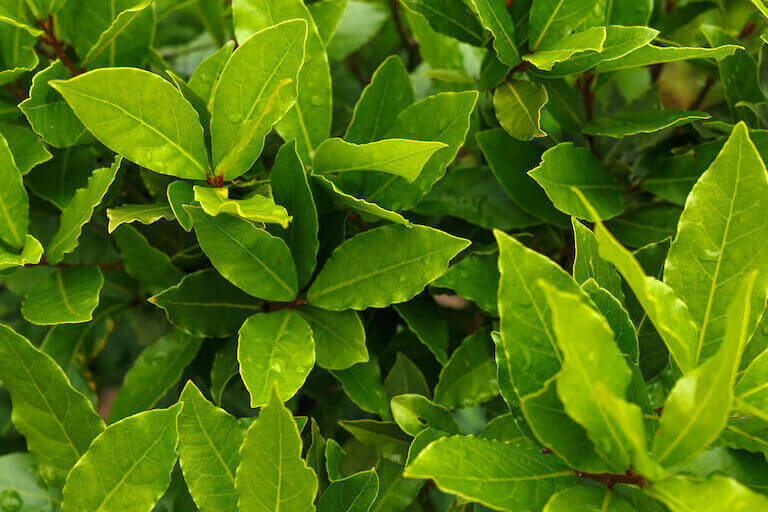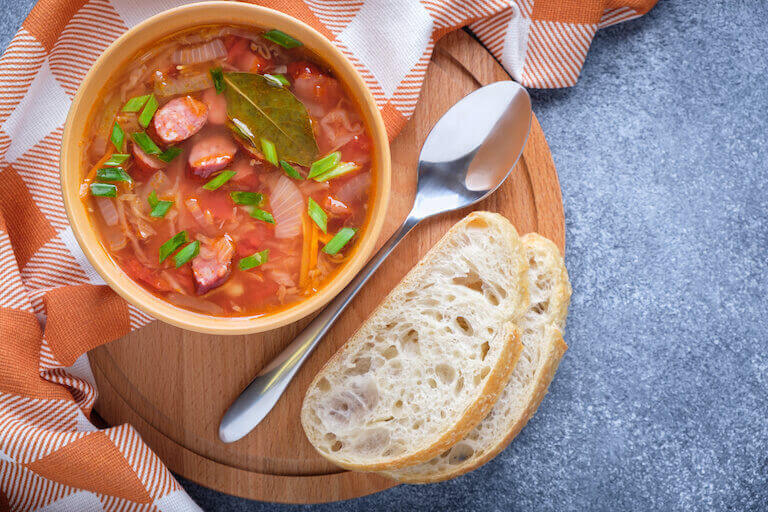Listen to This Article:
As a cook or chef, one of your goals is to create layers of flavor that meld to form a harmonious dish. One key element in reaching this goal? Understanding how to work with herbs and spices.
The bay leaf is a commonly-used herb in dishes ranging from a hearty beef stew to a fluffy rice pilaf. But despite its ubiquitous nature in the kitchen, many people have questions about its necessity and use.
Join us as we explore what exactly a bay leaf is as well as how to properly use it in the kitchen.
What Are Bay Leaves?
Bay leaves are the foliage of the bay laurel tree. These small trees are native to the Mediterranean region where they still grow today.

While many other spices and herbs are incorporated into dishes, bay leaves are often added whole to dishes to impart flavor and then removed before serving.
Dried bay leaves are the most common option since they can be easily stored and shipped. And since many of the flavor compounds present in bay leaves are non-volatile–meaning they don’t evaporate as the leaves dry–dried leaves provide just as much flavor as their fresh counterparts.
What’s the Difference Between Turkish and California Bay Leaves?
As you progress along your culinary journey, you may find that a recipe calls specifically for Turkish or California bay leaves. While these two types of leaves have similar flavors, they are two distinct ingredients.
Turkish bay leaves are what people typically refer to when they talk about bay leaves. These leaves come from the bay laurel tree—scientific name Laurus nobilis—that is native to the Mediterranean. These trees also go by the names true laurel, sweet laurel, and bay tree.
The leaves of true laurel trees are ovular in shape and impart a subtle flavor that can be described as a blend of oregano, thyme, and clove. A product labeled as “bay leaves” is likely the Turkish variety.
California bay leaves come from a completely different tree, the California bay laurel (Umbellularia californica). As the name suggests, these plants are native to the golden state.
Compared to Turkish bay leaves, the leaves from California bay laurels are more slender in shape. They also bring a more intense flavor that sometimes seems almost medicinal in flavor. Therefore, don’t swap California for the standard Turkish variety unless you’re aiming for a more intense taste and aroma.
How to Use Bay Leaves in Cooking
Typically, chefs add bay leaves to the dish while it cooks and then remove the leaves before serving. While the bay leaf flavor may start out harsh with hints of menthol, it will mellow as it cooks. The end result is a subtle flavor that’s reminiscent of black tea, oregano, thyme, and more.
While herbs like basil and cilantro often take center stage when incorporated into a dish, the bay leaf plays more of a supporting role. Taste a broth or braised meat that was made with a bay leaf and it is unlikely that this herb will be the prominent flavor. Still, bay leaves help create a well-rounded dish—a skill that can be one sign of a talented chef.

So, how should you use bay leaves in your cooking? You can try incorporating them into any dish that is cooked slowly—think stews, soups, braises, pasta sauce, and dried beans. They are equally at home in meat-centric dishes as well as plant-based stews.
You probably only need to use one or two leaves per dish, since the aromatic compounds spread throughout the dish. And make sure to leave the leaves whole so you can easily remove them later.
Are There Any Substitutes for Bay Leaves?
Like most ingredients, the bay leaf is unique. It provides a subtle yet unmistakable depth that’s hard to replicate if you’re caught without this herb.
However, if you’re in a pinch, you can try substituting a bit of oregano and/or thyme. Or, you can forego the bay leaf entirely with the expectation that your dish will taste a little flat.
“School can teach you each ingredient’s function and the science and chemistry so that you understand what’s happening. And when something does go wrong, you can recognize it and prevent that from happening in the future.”*
Anne Lanute, Escoffier Executive Chef
Continue Exploring Ingredients and Flavors
No matter where you are on your culinary journey, there’s always more to learn about the plethora of ingredients available. Not only are there new ingredients to learn about, but there are also advanced cooking techniques and recipes to try out!
Escoffier students can spend their time exploring flavor as they work with new ingredients and prepare a variety of dishes under the guidance of their Chef Instructors. By the end of their programs, they may find they have the confidence to combine new ingredients and create complex flavors.
If you’re interested in learning if culinary school could be for you, contact us today to learn more about our available programs.

Take the Culinary Career Survey
We’ve compiled a checklist of all of the essential questions into one handy tool: career options, culinary interest surveys, educational opportunities, and more.
To learn more about the world of culinary arts, read these next:
- How to Perfectly Pair Pasta and Sauces
- What Are Functional Mushrooms and How Can They Be Used in Cooking?
- 10 Tools You Need in Your Chef Utility Belt
*Information may not reflect every student’s experience. Results and outcomes may be based on several factors, such as geographical region or previous experience.
This article was originally published on August 13, 2015, and has since been updated.

 “School can teach you each ingredient’s function and the science and chemistry so that you understand what’s happening. And when something does go wrong, you can recognize it and prevent that from happening in the future.”*
“School can teach you each ingredient’s function and the science and chemistry so that you understand what’s happening. And when something does go wrong, you can recognize it and prevent that from happening in the future.”*